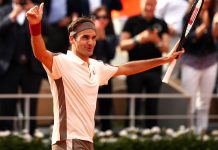PARIS
Reflections On the Man Who Made Hope Matter
Bill Simons
Muhammad Ali wasn’t like Michael Tyson. He didn’t go to snazzy tennis tournaments or hang out by courts or put his daughter into the game.
He wasn’t like Sugar Ray Leonard, who would dress up in fine tennis whites and flow about many a tennis court.
And he wasn’t like the grizzled fighter Tex Cobb, who liked to compare boxing to tennis and said, “If you screw up in tennis, it’s 15-love. If you screw up in boxing, it’s your ass, baby.”
Like Federer, Ali is a beloved international icon who is celebrated in every corner of the globe. Still, all the adoration that comes Roger’s way is just a modest portion of what was showered on Ali.
Billie Jean King – feisty and fierce – more than any other athlete changed women’s rights. Arthur Ashe emerged out of the American South to integrate a sport and help take down apartheid in South Africa.
But when Ali said “I ain’t got no quarrel with them Viet Cong” and then lost his heavyweight crown and was sentenced to five years in jail for his anti-war beliefs, he became a symbol for just about anyone who had a gripe with “the man” or a beef with “the system.”
Jackie Robinson changed race relations forever in America. Ali changed the world – and it’s no fluke that he impacted tennis. It’s not so much a matter that the young Jo-Wilfried Tsonga looked just like the boxer. Just last week Mathias Bourgue’s coach told France’s 16th-best player to study tapes of Ali before playing Andy Murray. Inspired and in the zone, Bourgue almost beat the No. 2 player in the world.
How ironic. In tennis there is no greater fan of boxing than Murray. A while ago, I asked him to compare boxers with tennis players. He replied, “I’d say Roger Federer would be like Sugar Ray Leonard, renowned for his style. Rafael Nadal would be like Manny Pacquiao; ferocious, powerful and relentless. Novak Djokovic would be like Roberto Duran; as tough and versatile as they come. I’ll pick Floyd Mayweather for myself; he’s my favorite boxer to watch.”
It’s hardly surprising that boxing and tennis are often compared. Murray, Caroline Wozniacki and Vika Azarenka all have used the sweet science of boxing to train for tennis.
More to the point, all-time tennis great Jack Kramer always contended that the two sports’ violent and not-so-violent aspects were two sides of the same coin. Both are played around the world, and in both, you are thrown out there in the ring to fight an “It’s you or me baby” gladiatorial battle. In both, having a knock-out punch is vital. So is having quick hands and feet, focus, stamina and mental toughness. You have to be able to take a punch. Those with glass chins need not apply.
Tennis’ great loyalist John McEnroe even had the gumption to claim that tennis was tougher than boxing.
He argued that tennis is “an unforgiving, sometimes brutal sport…It is like being undressed in public and is about as lonely as a boxing match. At least in boxing, if you freeze, some guy will, more than likely, pop you and put you out of your misery. But in tennis there is no escape.”
Actually, there is something very primal about boxing and tennis and it’s hardly surprising that boxers and tennis players like each other. So we see Serena, in the Wimbledon tea room, hanging out with Lennox Lewis. Or we read an admiring tweet upon the death of Joe Frazier. There’s George Foreman, again and again mingling at the US Open.
More than any other sport, boxing seems to hover, just a bit, over tennis. When Maria Sharapova was developing her Sugarpova candy, she jokingly told us that she was considering bringing in Sugar Ray Leonard as a consultant. When Michael Chang – a fast-moving diminutive underdog – brought down the mighty, but stiff, Ivan Lendl at the 1989 French Open, many compared it with the fleet, undersized Cassius Clay whipping the supposed unbeatable goliath Sonny Liston to become the heavyweight champ in 1964 in Miami Beach.
Another pretty lively town – Las Vegas – brings boxing and tennis together like no other place. The best junior to emerge out of Vegas recently was Asia Muhammad. Michael Tyson volunteers continually to promote inner-city tennis programs in Vegas, and his seven-year-old daughter Milan is a bit of a tennis prodigy who recently drew praise from none other then Goran Ivanisivic.
The life of Iranian Michael Agassi – the son of the city’s most famous athlete – was completely transformed when he felt the Olympic’s boxing judges robbed him of a medal at the 1952 Helsinki games. He became obsessed with somehow getting back some of the glory he felt was his. He made his way to Chicago, Los Angeles and eventually Vegas, where he built a tennis court in his backyard and hung a tennis ball over the crib of his infant Andre. And the rest is Agassian history.
Of course, the greatest boxing-tennis comparison is the eerie similarity of the Ali-Frazier rivalry and the Federer-Nadal match-up.
“Discussing Frazier’s boxing career, without bringing up Ali,” said writer Mike Sielski, “is like talking about Neil Armstrong without mentioning the moon.”
David Halberstam noted, “The only way we know of Ali’s greatness is because of Frazier’s equivalent greatness…These are men who, like it or not, have become prisoners of each other.”
Both boxing and tennis rivalries gave us delectable contrasts that showcased many of the wide-ranging aspects of the sports. In both Ali and Federer we saw the graceful, light on-his-feet, poetic (“float like a butterfly, sting like a bee”) pretty fellow use eye-hand coordination and athletic grace to go against a far more muscular and explosive powerhouse who compulsively and relentlessly bored in and punched and pounded and would do anything not to go down.
No other sports, more than boxing and tennis, invite mind-numbing “GOAT” debates on who is the greatest of all time. The records are clear. Ali prevailed in two of his three bouts with Frazier, while Rafa has a whopping 23-11 lead over Roger. Let the debate begin.
Still, when it comes to Ali, it’s clear. His claim, “I am the greatest” rings true. It’s not because the king of rants, who was the father of trash talk, complained, “It’s hard to be humble when you’re as great as I am.” Or that he suggested, “If you even dream of beating me you’d better wake up and apologize.”
And ultimately it wasn’t only about his mighty prowess in the ring. Rather, it was his impact outside of it. His biographer Thomas Hauser noted that Ali came along and preached “freedom and equality of a kind rarely seen anywhere in the world.”
The man told underdogs everywhere, “Impossible is just a big word thrown around by small men who find it easier to live in the world.” To Ali, “Only a man who knows what it is like to be defeated can reach down to the bottom of his soul and come up with the extra ounce of power it takes to win.” He insisted, “If my mind can conceive it, and my heart can believe it – then I can achieve it.”
In the end, he told us, “Don’t count the days; make the days count.”
Ali’s days counted. After all, didn’t he, more than any other athlete – say, Babe Ruth, Jesse Owens, Jackie Robinson, Pele, Michael Jordan or tennis’ very own Ashe and King – transform the world?
Whether knocking out Liston or battling Foreman or Frazier, whether in a little gym in Louisville or a little village in the Congo; whether changing his name or changing our long held perceptions, whether sticking with his convictions and bravely standing up to the man or reaching up to light the Olympic torch with his trembling hand, he made aspiration seem real.
Somehow, some way, the man rather suddenly managed to make hope matter.



















